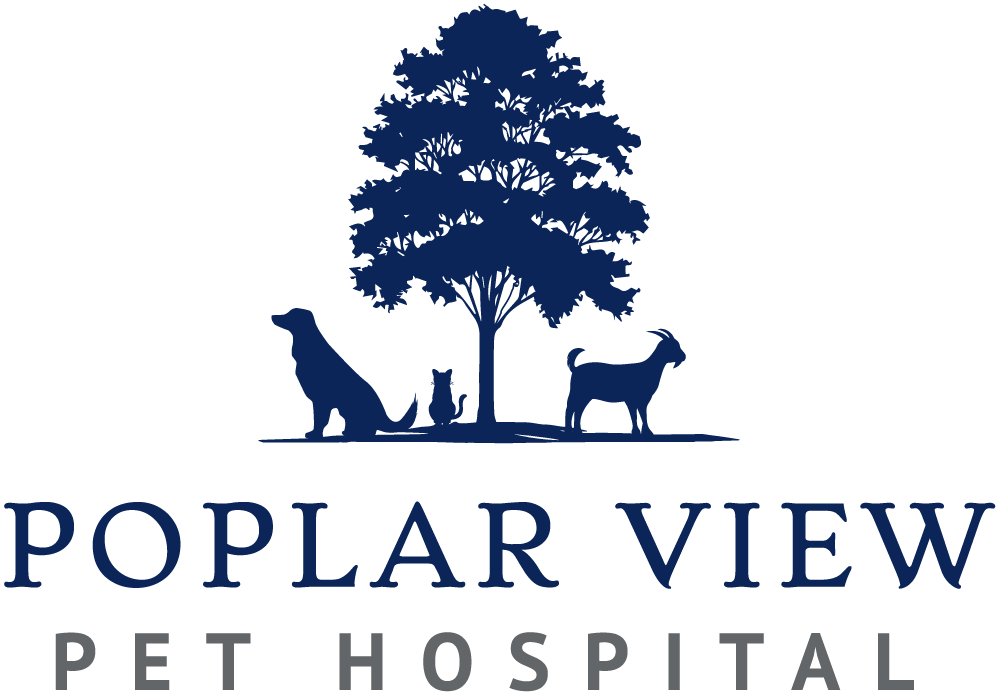Has your furry friend been experiencing digestive issues lately? Giardia in dogs could be the culprit behind those troubling symptoms. This microscopic parasite affects many dogs each year, with approximately 15.6% of dogs brought to veterinary clinics with stomach problems in the United States testing positive for this tiny troublemaker.
If you notice persistent diarrhea or other digestive symptoms in your dog, don’t wait to seek help. Visit Poplar View Pet Hospital for proper diagnosis and wellness care to get your pet back to their happy, healthy self as quickly as possible.
Understanding Giardia in Dogs
Giardia is a microscopic, single-celled parasite that infects the small intestine of dogs and many other animals, including humans. This protozoan organism has a two-stage life cycle. It exists as active trophozoites that attach to the intestinal wall and as hardy cysts that are passed into the environment through feces. Once ingested, these cysts can survive the stomach acid and develop into trophozoites in the small intestine. This is where they start to cause problems by interfering with normal nutrient absorption.
6 Common Symptoms of Giardia in Dogs
- Watery diarrhea – The most common and noticeable symptom, often appearing pale, greasy, and with a particularly foul odor that may come and go over weeks.
- Weight loss – Dogs may lose weight despite maintaining a normal appetite due to the parasite interfering with proper nutrient absorption in the intestines.
- Vomiting – Some infected dogs experience occasional vomiting alongside diarrhea, though this is less common than the intestinal symptoms.
- Lethargy – Infected dogs often show reduced energy levels and may seem unusually tired or uninterested in normal activities.
- Dehydration – Persistent diarrhea can lead to fluid loss, causing symptoms like dry gums, sunken eyes, and reduced skin elasticity.
- Poor coat appearance – Due to its nutritional impact, Giardia in dogs can result in a dull, dry hair coat that lacks its usual shine and softness.
Is giardia the same as parvo?
Giardia and parvovirus (parvo) are completely different pathogens that cause distinct diseases in dogs. However, both affect the digestive system. Giardia is a protozoan parasite that primarily causes intestinal upset and diarrhea. Parvo, on the other hand, is a highly contagious virus that causes severe bloody diarrhea, vomiting, and immune system suppression. Parvo requires immediate emergency veterinary care and has a much higher mortality rate. Meanwhile, Giardia in dogs is rarely fatal with proper treatment.
How Does a Dog Catch Giardia
Contaminated Water Sources
Dogs can become infected with Giardia when drinking from contaminated puddles, lakes, streams, or other untreated water sources. The parasite’s hardy cysts can survive for months in cool, moist environments. This makes natural water bodies ideal transmission points. A single lap from a contaminated puddle or stream can deliver enough cysts to establish an infection. This is why outdoor water sources pose such a significant risk for dogs who enjoy swimming or hiking with their owners.
Contact with Infected Feces
Direct contact with feces from an infected animal is another common transmission route for Giardia. Dogs naturally explore their environment with their noses and mouths. They can sometimes investigate or even consume the feces of other animals. When a healthy dog comes into contact with infected feces, whether through direct ingestion or by licking paws or fur that has touched contaminated material, they can easily pick up Giardia cysts. This risk is particularly high in dog parks, kennels, and other areas where many dogs congregate.
Contaminated Environments
Giardia in dogs can spread through contaminated environments where the parasite’s cysts have been deposited. These microscopic parasites can cling to surfaces, toys, bedding, and even your dog’s fur or paws. When dogs groom themselves after contact with contaminated surfaces, they can ingest the cysts. Home environments where an infected dog has had accidents can remain contaminated for weeks without proper disinfection. This creates an ongoing exposure risk for all pets in the household.
7 Tips for Preventing Giardia in Dogs
- Provide clean drinking water – Always offer fresh, clean water from a reliable source and avoid letting your dog drink from puddles, lakes, or streams during walks or hikes.
- Practice proper waste management – Pick up your dog’s waste promptly and dispose of it properly to prevent environmental contamination and reduce infection risks.
- Maintain good hygiene – Wash your hands thoroughly after handling your dog’s waste and before preparing your pet’s food to prevent accidental transmission.
- Regular veterinary check-ups – Schedule routine wellness exams that include fecal testing, even if your dog isn’t showing symptoms, as Giardia in dogs can sometimes be present without obvious signs.
- Quarantine infected dogs – Keep infected dogs separated from other pets in your household and clean shared areas thoroughly to prevent spreading the parasite.
- Clean and disinfect regularly – Wash your dog’s bedding, toys, and water bowls frequently with hot water and pet-safe disinfectants to eliminate potential infective cysts.
- Avoid high-risk areas – Limit exposure to places where dogs frequently eliminate, such as certain areas of dog parks or kennels with poor sanitation practices.
What are the risks of giardia in dogs?
Dehydration
Persistent watery diarrhea caused by Giardia in dogs can quickly lead to dangerous levels of dehydration. The body loses essential fluids and electrolytes faster than they can be replenished. If left untreated, severe dehydration can progress to shock, organ failure, and even death in extreme cases, making it the most immediate serious risk of Giardia infection.
Malnutrition and Weight Loss
Giardia interferes with a dog’s ability to absorb nutrients. It damages the small intestinal lining and disrupts the normal digestive process. Even when eating normal amounts of food, infected dogs may experience severe weight loss as the parasites steal their nutrition. This can be particularly dangerous for growing puppies, senior dogs, and those already dealing with other health issues
Spread to Humans (Zoonotic Risk)
While not all strains of Giardia in dogs readily infect humans, some types of the parasite can cross between species. Children, elderly individuals, and those with compromised immune systems face the highest risk of contracting Giardia in dogs. Transmission typically occurs through accidental ingestion of microscopic amounts of contaminated fecal matter. This highlights the importance of rigorous hygiene practices like handwashing after handling pets or their waste.
What kills giardia in dogs?
Prescription Medications
Veterinarians typically prescribe antiprotozoal medications such as metronidazole (Flagyl) or fenbendazole (Panacur) to eliminate Giardia in dogs. These medications work by stopping the parasite’s ability to survive within the intestinal tract. Treatment usually continues for 5-10 days, though some stubborn cases may require extended therapy or combination treatments.
Environmental Decontamination
Eliminating Giardia in dogs from your home requires thorough cleaning with specific disinfectants. Quaternary ammonium compounds or steam cleaning can kill Giardia cysts on surfaces. Regular household bleach can also be effective. Clean areas where your dog spends time and items that may have fecal contamination to prevent reinfection.
Supportive Care
Supporting your dog’s recovery from Giardia involves more than just killing the parasite. It requires treatment of the intestinal damage and digestive upset caused by the infection. Veterinarians often recommend a bland, easily digestible diet during treatment to reduce intestinal inflammation and stress. Probiotics specifically formulated for dogs can help restore healthy gut flora.
How to Treat Giardia at Home
- Follow medication instructions precisely – Administer all prescribed medications exactly as directed by your veterinarian, even if symptoms improve before the course is complete.
- Provide fresh water constantly – Keep clean water available at all times to prevent dehydration, changing it frequently to avoid potential recontamination.
- Feed a bland diet temporarily – Offer easily digestible foods like boiled chicken and rice or veterinary-prescribed gastrointestinal diets to rest the irritated digestive tract during recovery.
- Bathe your dog regularly – Give your pet periodic baths during treatment, focusing carefully on the rear end to remove any cysts that might be caught in fur and prevent self-reinfection through grooming.
- Disinfect bedding and toys – Wash all fabric items in hot water and clean hard surfaces with appropriate disinfectants to eliminate environmental cysts that could cause reinfection.
- Prevent access to feces – Clean up waste immediately after your dog eliminates to reduce environmental contamination and minimize reinfection risks.
- Isolate infected pets – Keep dogs with Giardia separated from other household pets during treatment to prevent spreading the infection throughout your pet family.
Conclusion
Giardia in dogs is a manageable condition when diagnosed and treated. However, it requires attentive care and thorough environmental management to ensure complete resolution. Understanding how this parasite spreads and recognizing the symptoms early can help protect your dog from prolonged discomfort and potential complications.
If you notice persistent diarrhea, weight loss, or other digestive issues in your pet, don’t hesitate to schedule an appointment with us at Poplar View Pet Hospital. Our experienced team can provide accurate diagnosis and effective treatment plans tailored to your dog’s specific needs. For more pet health tips and updates, follow us on Facebook and Instagram, where we share valuable information to help keep your furry family members in optimal health.

